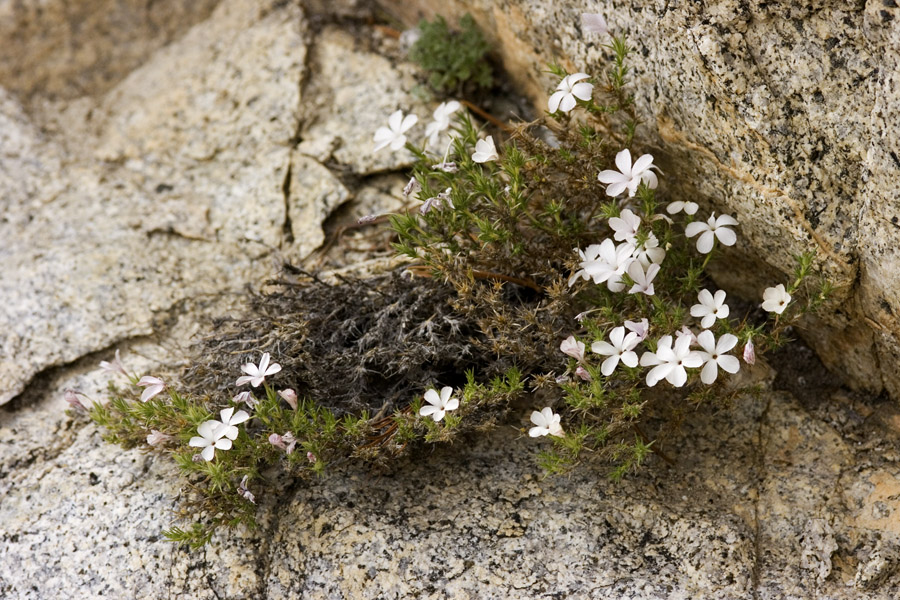|
|
|
|
Family: Polemoniaceae
granite prickly phlox
[Gilia hallii Parish, moreGilia pungens (Torr.) Benth., Gilia pungens var. hookeri (Douglas ex Hook.) A.Gray, Leptodactylon hazeliae M.E. Peck, Leptodactylon lilacinum Greene ex Brand, Leptodactylon pungens (Torr.) Nutt., Leptodactylon pungens subsp. brevifolium (Rydb.) Wherry in R.J.Davis, Leptodactylon pungens subsp. eupungens (Brand) Wherry, Leptodactylon pungens subsp. hallii (Parish) H. Mason, Leptodactylon pungens subsp. hazeliae (Peck) R.J. Meinke, Leptodactylon pungens subsp. hookeri (Douglas ex Hook.) Wherry, Leptodactylon pungens subsp. pulchriflorum (Brand) H.Mason, Leptodactylon pungens subsp. squarrosum (A.Gray) Tidestr. ex Wherry, Leptodactylon pungens var. hallii (Parish) Jeps., Leptodactylon pungens var. hookeri (Douglas ex Hook.) Wherry] |
PLANT: Subshrub, 1-4 dm tall, branching mostly below the middle; stems ascending to erect, glandular and pilose. LEAVES: opposite below, alternate above, palmately to pinnately lobed, the 3-9 lobes linear to narrowly oblong, glabrous to pubescent, spinulose, the upper leaves subtending clusters of short leaves. FLOWERS: calyx 6-10 mm long, glabrous to sparsely pubescent, the lobes slightly unequal, usually shorter than the tube; corolla nocturnal, closed during the day, salverform, 14-20(25) mm long, cream to ligh yelloworange, the throat often tinged lavender or purple; stamens 5, inserted on the upper tube; stigmas 3; ovary with 3 locules. NOTES: Sandy to rocky soils, shrubland, coniferous forest and woodland; Apache, Coconino, Navajo cos.; 1700-2100 m (5600-7000 ft); May-Sep. B.C. to MT, s to CA and NM. REFERENCES: Dieter H. Wilken and J. Mark Porter, 2005, Vascular Plants of Arizona: Polemoniaceae. CANOTIA 1: 1-37. General: Perennial subshrub, 10-60 cm tall; stems ascending to erect, branching below the middle, finely puberulent or glandular-puberulent; caudex woody, branched. Leaves: Cauline, numerous, crowded, opposite below, alternate above, palmately to pinnately lobed, 5-12 mm long, the lobes 3-9, linear to awl-shaped, rigid, glabrous to pubescent, the apices spine-tipped, the upper leaves subtending clusters of axillary leaves. Flowers: Inflorescence of 2-5 flowers in compact leafy-bracted clusters terminating the branches; flowers nearly sessile; calyx narrowly campanulate, 6-10 mm long, glabrous to pubescent; corolla salverform, 8-15 mm long, white, the throat yellow, puberulent; style slightly exserted; flowers May-September. Fruits: Capsule, ovoid to oblong, 3.5-5 mm long, 3-locular; seeds several per locule. Ecology: Shrublands, woodlands, open pine forests, rocky to sandy soils; 500-2400 m (1500-8000 ft); Apache, Coconino, Mohave, and Navajo counties; western U.S. and Canada, northern Mexico. Notes: Leptosiphon nuttallii is distinguished from Linanthus pungens by its softer leaves, smaller corolla (8-15 mm long), and yellow throat. The Navajo use prickly phlox to treat scorpion stings and kidney disease. Editor: Springer et al. 2008 |
|
|
|


